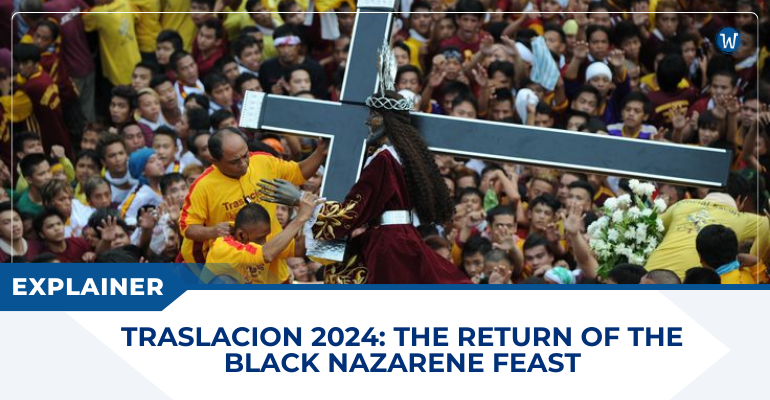The long-awaited return of the Black Nazarene Traslacion after a three-year hiatus has sparked anticipation and fervor among devotees. On January 9, Quiapo will once again be the epicenter of one of the world’s most intense displays of Catholic faith.
Annually, millions gather to honor Nuestro Padre Señor Jesus de Nazareno’s arrival from Luneta to Quiapo. The revered image is Jesus the Black Nazarene.
When is Black Nazarene Celebrated?
The feast occurs every January 9, attracting throngs of devotees to the Quiapo Church, also known as the Minor Basilica of the Black Nazarene and St. John the Baptist Parish. The image is deeply ingrained in Filipino devotion, deemed miraculous by its followers.
However, while many call the January 9 event the feast of the Black Nazarene, it actually signifies the transfer of the image from Intramuros to Quiapo Church. The depiction of the suffering Christ, portrayed by the image, finds its religious significance during Holy Week’s Good Friday.
How many years have passed since we initially celebrated the Black Nazarene? Well, we’re commemorating the 407th anniversary of this saint. The story of the celebration traces back to the 17th century when a Spanish priest brought the statue from Mexico to the Philippines.
Fiesta of Black Nazarene Tradition and Expectations
The upcoming celebration will feature hourly masses starting at midnight and concluding at 11 p.m. The fiesta of Black Nazarene will be livestreamed, allowing remote participation for those unable to physically attend.
The Traslacion route will commence at the Quirino Grandstand, culminating at Quiapo Church. Devotees, in reverence, will approach the 400-year-old statue of the Black Nazarene, housed in a protective glass case, with a portion of the Nazarene’s cross accessible for direct contact.
Certain items like hats, umbrellas, backpacks, and non-transparent liquid bottles are prohibited during the Traslacion by the Philippine National Police for security reasons.
Despite the hiatus due to COVID-19 threats, the event made a modified return termed the “Walk of Faith” in 2023, lacking the customary procession of the Nuestro Padre Señor Jesus de Nazareno statue.
The Feast of Sto. Nino 2024
Coinciding with this passionate celebration is the Feast of Sto. Nino, a distinctly Filipino devotion celebrated on Sunday. It holds a significant place in the nation’s Christian identity and history. Cebu becomes the focal point for millions of devotees, marking the beginning of the year’s festivities akin to Mardi Gras in other cultures.
These feasts symbolize the Philippines’ strong Christian faith, emphasizing unity under the Cross and Crown from Spanish missionaries. Despite differences, they unify. While the Black Nazarene Feast revolves around the veneration of a centuries-old image, the feast of Sto. Nino in Cebu signifies a vibrant cultural celebration rooted in Christian history.
Conclusion
The simultaneous celebration of the Black Nazarene Feast and the Feast of Sto. Nino embodies the diverse yet unified Christian identity of the Filipino nation. These annual events stand as testimony to the enduring faith and cultural heritage of the Philippines, attracting millions in expressions of devotion and celebration.
Also Read: Is January 9, 2024, a holiday in the Philippines?



Leave a Reply